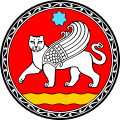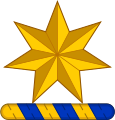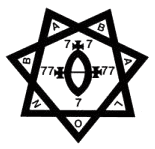نجمة سباعية
| Regular heptagram (7/2) | |
|---|---|
 heptagram منتظم | |
| النوع | مضلع نجمي منتظم |
| الأضلاع والرؤوس | {{{p7/2-جوانب}}} |
| رمز شلفلي | {{{{p7/2-شلفلي}}}} |
| مخططات كوكستر-دنكن | |
| مجموعة التماثل | ثنائي الأسطح (D{{{p7/2-جوانب}}}) |
| الزاوية الداخلية (الدرجات) | {{{زاوية p7/2}}}° |
| الخصائص | نجمي، دائري، متساوي الأضلاع، متوازي، متجانس الأضلاع |
| Regular heptagram (7/3) | |
|---|---|
 heptagram منتظم | |
| النوع | مضلع نجمي منتظم |
| الأضلاع والرؤوس | {{{p7/3-جوانب}}} |
| رمز شلفلي | {{{{p7/3-شلفلي}}}} |
| مخططات كوكستر-دنكن | |
| مجموعة التماثل | ثنائي الأسطح (D{{{p7/3-جوانب}}}) |
| الزاوية الداخلية (الدرجات) | {{{زاوية p7/3}}}° |
| الخصائص | نجمي، دائري، متساوي الأضلاع، متوازي، متجانس الأضلاع |
| المضلعات النجمية |
|---|
|
|
النجمة السباعية heptagram هي نجمة لها سبعة رؤوس.
The name heptagram combines a numeral prefix, hepta-, with the Greek suffix -gram. The -gram suffix derives from γραμμῆ (grammē) meaning a line.[1]
الهندسة
In general, a heptagram is any self-intersecting heptagon (7-sided polygon).
There are two regular heptagrams, labeled as {7/2} and {7/3}, with the second number representing the vertex interval step from a regular heptagon, {7/1}.
This is the smallest star polygon that can be drawn in two forms, as irreducible fractions. The two heptagrams are sometimes called the heptagram (for {7/2}) and the great heptagram (for {7/3}).
The previous one, the regular hexagram {6/2}, is a compound of two triangles. The smallest star polygon is the {5/2} pentagram.
The next one is the {8/3} octagram and its related {8/2} star figure (a compound of two squares), followed by the regular enneagram, which also has two forms: {9/2} and {9/4}, as well as one compound of three triangles {9/3}.
 {7/2} |
 {7/3} |
 {7}+{7/2}+{7/3} |
 7-2 prism |
 7-3 prism |
 Complete graph |
 7-2 antiprism |
 7-3 antiprism |
 7-4 antiprism |
الاستخدامات
الأعلام والبيارق
Roundel of the Georgian Air Force
Flag of Eastern Band Cherokee
The seven-pointed star of the Felibritge on the Occitan flag.
The Jordanian flag, bearing the star that symbolizes Al-Fatiha
Symbol of Hokkaido
Coat of arms of Samarkand
Commonwealth Star as the crest of Coat of Arms of Australia
- The seven-pointed star is incorporated into the flags of various bands of Cherokee Indians and the badges of Navajo Nation Police (as well as other police).
- The Bennington flag, a historical American Flag, has thirteen seven-pointed stars along with the numerals "76" in the canton.
- The Flag of Jordan contains a seven-pointed star.
- The Flag of Australia employs five heptagrams and one pentagram to depict the Southern Cross constellation and the Commonwealth Star.
- Some old versions of the coat of arms of Georgia (country) including the Georgian Soviet Socialist Republic used the {7/2} heptagram as an element.
- A seven-pointed star is used as the badge in many sheriff's departments and some smaller-community police departments.
- A seven-pointed star is used in the otherkin pride flag.
إنفاذ القانون
Seal of the California Highway Patrol
الرمزية الدينية
- The heptagram became a traditional symbol for warding off evil in Catholicism.
- The symbol is also used in Kabbalist Judaism.
- في الإسلام، the heptagram is used to represent the first seven verses in the Quran.
- The heptagram is used in the symbol for Babalon in Aleister Crowley's occult system Thelema.
- The heptagram is known among neopagans as the Elven Star or Fairy Star. It is treated as a sacred symbol in various modern pagan and witchcraft traditions. Blue Star Wicca also uses the symbol, where it is referred to as a septegram. The second heptagram is a symbol of magical power in some pagan spiritualities.
- In alchemy, a seven-sided star can refer to the seven planets which were known to early alchemists, and also, the seven alchemical substances: fire, water, air, earth, sulphur, salt and mercury.
- In Polynesia, the seven-pointed star is used often in imagery, basket making, tattoos, and is considered to be a symbol of Kanaloa, the first Polynesian navigator.[2][3]
- The seven-sided star is an important symbol of the Cherokee people of southern Appalachia, representing the seven clans of the Cherokee and the sacred number seven.
في الثقافة الشعبية

- The logo of American shoe brand DC Shoes features a 7/3 heptagram in the letter C.
- The seven-pointed star is used as the logo for the international Danish shipping company A.P. Moller–Maersk Group, sometimes known simply as Maersk.
- In George R. R. Martin's novel series A Song of Ice and Fire and its TV version Game of Thrones, a seven-pointed star serves as the symbol of the Faith of the Seven.
- In the manga series MeruPuri, a magical mirror/ portal is in the shape of a heptagram. The symbol is also seen during spellcasting.
- Finnish rock band HIM used a heptagram on the cover of their eighth studio album Tears on Tape.
- American heavy metal band Darkest Hour used a heptagram on the cover of their eighth studio album Darkest Hour.
- English Singer Damon Albarn uses a heptagram as a symbol in his solo performances.
- The {7/3} heptagram is used by some members of the otherkin subculture as an identifier.
- The American Progressive Rock Metal Band “Tool” uses an ‘open’ seven pointed symbol for their fan group, The Tool Army. It is ‘open’ to signify an invitation into the collective unconscious.
- An alternate logo of Chicago-based Children's Press from 1945 to 1970, having the slogan "Children's Books Are Important".
انظر أيضا
- نجمة (رمز)
- Grünbaum–Rigby configuration
- Star polygon
- Stellated polygons
- Two-dimensional regular polytopes
- Major (United States) insignia of seven leaves
المراجع
- ^ γραμμή, Henry George Liddell, Robert Scott, A Greek-English Lexicon, on Perseus
- ^ "HUNA INTERNATIONAL - Your best resource for Huna Knowledge and Practice". www.huna.org.
- ^ Melville, Leinani (1969). Children of the Rainbow: A Book Concerning the Religion, Legends, and Gods of the Natives of Pre-Christian Hawaii. ISBN 0835600025.
ببليوگرافيا
- Grünbaum, B. and G. C. Shephard; Tilings and Patterns, New York: W. H. Freeman & Co., (1987), ISBN 0-7167-1193-1.
- Grünbaum, B.; Polyhedra with Hollow Faces, Proc of NATO-ASI Conference on Polytopes ... etc. (Toronto 1993), ed T. Bisztriczky et al., Kluwer Academic (1994) pp. 43–70.









